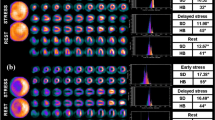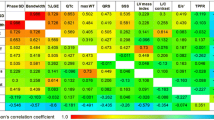Abstract
To compare the left ventricular (LV) phase dyssynchrony parameters obtained from Tc-99m Sestamibi SPECT (GSPECT) and F-18 FDG PET(GPET), as well as the prognostic values in patients with ischemic cardiomyopathy (ICM). Consecutive ICM patients referred for myocardial viability assessment were retrospectively evaluated and were followed-up for 21 ± 5 months. Phase parameter from both GSPECT and GPET were analyzed by QGS software, including histogram bandwidth (BW), standard deviation (SD) and entropy. Independent predictor for cardiac death was analyzed by Cox regression analysis. The estimated cardiac survival curve was analyzed by and was compared with the log-rank test. Eight-eight (mean age 56 ± 10, male 94%, LVEFSPECT23 ± 10%) ICM patients were included for analysis. Moderate correlations were observed for BW (r = 0.65; p < 0.001), SD (r = 0.63; p < 0.001) and entropy (r = 0.73; p < 0.001) between GSPECT and GPET. Among all covariates, the extent of myocardial scar was significantly associated with the differences of SD (r = 0.22; p < 0.05) and entropy (r = − 0.7; p < 0.05), whereas the extent of myocardial viability was not (all p > 0.05). Entropy measured by GSPECT was the predictor for cardiac death (p = 0.037) while QRS duration was not. The cardiac survival of patients with a high entropy (≥ 59%) was significantly lower than that of patients with low entropy (< 59%) (p < 0.05). GSPECT and GPET-derived phase parameters were not interchangeable in ICM patients. Patients with LV dyssynchrony measured by gated SPECT were associated with a worse outcome.




Similar content being viewed by others
References
Chen J, Garcia EV, Bax JJ, Iskandrian AE, Borges-Neto S, Soman P (2011) SPECT myocardial perfusion imaging for the assessment of left ventricular mechanical dyssynchrony. J Nucl Cardiol 18(4):685–694. https://doi.org/10.1007/s12350-011-9392-x
Henneman MM, Chen J, Dibbets-Schneider P, Stokkel MP, Bleeker GB, Ypenburg C, van der Wall EE, Schalij MJ, Garcia EV, Bax JJ (2007) Can LV dyssynchrony as assessed with phase analysis on gated myocardial perfusion SPECT predict response to CRT? J Nucl Med 48(7):1104–1111. https://doi.org/10.2967/jnumed.107.039925
Delgado V, van Bommel RJ, Bertini M, Borleffs CJ, Marsan NA, Arnold CT, Nucifora G, van de Veire NR, Ypenburg C, Boersma E, Holman ER, Schalij MJ, Bax JJ (2011) Relative merits of left ventricular dyssynchrony, left ventricular lead position, and myocardial scar to predict long-term survival of ischemic heart failure patients undergoing cardiac resynchronization therapy. Circulation 123(1):70–78. https://doi.org/10.1161/CIRCULATIONAHA.110.945345
Uebleis C, Hellweger S, Laubender RP, Becker A, Sohn HY, Lehner S, Haug A, Bartenstein P, Cumming P, Van Kriekinge SD, Slomka PJ, Hacker M (2012) Left ventricular dyssynchrony assessed by gated SPECT phase analysis is an independent predictor of death in patients with advanced coronary artery disease and reduced left ventricular function not undergoing cardiac resynchronization therapy. Eur J Nucl Med Mol Imaging 39(10):1561–1569. https://doi.org/10.1007/s00259-012-2157-1
Pazhenkottil AP, Buechel RR, Husmann L, Nkoulou RN, Wolfrum M, Ghadri JR, Kummer J, Herzog BA, Kaufmann PA (2011) Long-term prognostic value of left ventricular dyssynchrony assessment by phase analysis from myocardial perfusion imaging. Heart 97(1):33–37. https://doi.org/10.1136/hrt.2010.201566
Wei H, Tian C, Schindler TH, Qiu M, Lu M, Shen R, Tian Y, Zhao SH, Zhang X (2014) The impacts of severe perfusion defects, akinetic/dyskinetic segments, and viable myocardium on the accuracy of volumes and LVEF measured by gated (9)(9)mTc-MIBI SPECT and gated (1)(8)F-FDG PET in patients with left ventricular aneurysm: cardiac magnetic resonance imaging as the reference. J Nucl Cardiol 21(6):1230–1244. https://doi.org/10.1007/s12350-014-9978-1
Zhang X, Liu XJ, Wu Q, Shi R, Gao R, Liu Y, Hu S, Tian Y, Guo S, Fang W (2001) Clinical outcome of patients with previous myocardial infarction and left ventricular dysfunction assessed with myocardial (99m)Tc-MIBI SPECT and (18)F-FDG PET. J Nucl Med 42(8):1166–1173
Zhang F, Yang W, Wang Y, Tang H, Wang J, Shao X, Wang Z, Zhang X, Yang L, Wang X, Zhou W (2018) Is there an association between hibernating myocardium and left ventricular mechanical dyssynchrony in patients with myocardial infarction? Hell J Nucl Med 21(1):28–34. https://doi.org/10.1967/s002449910704
Pazhenkottil AP, Buechel RR, Nkoulou R, Ghadri JR, Herzog BA, Husmann L, Wolfrum M, Kuest SM, Fiechter M, Gaemperli O, Kaufmann PA (2011) Left ventricular dyssynchrony assessment by phase analysis from gated PET-FDG scans. J Nucl Cardiol 18(5):920–925. https://doi.org/10.1007/s12350-011-9411-y
Wang L, Wei HX, Yang MF, Guo J, Wang JF, Fang W, Wang YT (2013) Phase analysis by gated F-18 FDG PET/CT for left ventricular dyssynchrony assessment: a comparison with gated Tc-99m sestamibi SPECT. Ann Nucl Med 27(4):325–334. https://doi.org/10.1007/s12149-013-0691-y
Kano N, Okumura T, Isobe S, Sawamura A, Watanabe N, Fukaya K, Mori H, Morimoto R, Kato K, Bando YK, Murohara T (2018) Left ventricular phase entropy: Novel prognostic predictor in patients with dilated cardiomyopathy and narrow QRS. J Nucl Cardiol 25(5):1677–1687. https://doi.org/10.1007/s12350-017-0807-1
Braunwald E (2013) Heart failure. JACC Heart Fail 1(1):1–20. https://doi.org/10.1016/j.jchf.2012.10.002
Koyanagawa K, Naya M, Aikawa T, Manabe O, Kuzume M, Ohira H, Tsujino I, Tamaki N, Anzai T (2019) Prognostic value of phase analysis on gated single photon emission computed tomography in patients with cardiac sarcoidosis. J Nucl Cardiol. https://doi.org/10.1007/s12350-019-01660-9
Hess PL, Shaw LK, Fudim M, Iskandrian AE, Borges-Neto S (2017) The prognostic value of mechanical left ventricular dyssynchrony defined by phase analysis from gated single-photon emission computed tomography myocardial perfusion imaging among patients with coronary heart disease. J Nucl Cardiol 24(2):482–490. https://doi.org/10.1007/s12350-015-0388-9
Shimizu M, Iiya M, Fujii H, Kimura S, Suzuki M, Nishizaki M (2019) Left ventricular end-systolic contractile entropy can predict cardiac prognosis in patients with complete left bundle branch block. J Nucl Cardiol. https://doi.org/10.1007/s12350-019-01739-3
Brignole M, Auricchio A, Baron-Esquivias G, Bordachar P, Boriani G, Breithardt OA, Cleland J, Deharo JC, Delgado V, Elliott PM, Gorenek B, Israel CW, Leclercq C, Linde C, Mont L, Padeletti L, Sutton R, Vardas PE, Guidelines ESCCfP, Zamorano JL, Achenbach S, Baumgartner H, Bax JJ, Bueno H, Dean V, Deaton C, Erol C, Fagard R, Ferrari R, Hasdai D, Hoes AW, Kirchhof P, Knuuti J, Kolh P, Lancellotti P, Linhart A, Nihoyannopoulos P, Piepoli MF, Ponikowski P, Sirnes PA, Tamargo JL, Tendera M, Torbicki A, Wijns W, Windecker S, Document R, Kirchhof P, Blomstrom-Lundqvist C, Badano LP, Aliyev F, Bansch D, Baumgartner H, Bsata W, Buser P, Charron P, Daubert JC, Dobreanu D, Faerestrand S, Hasdai D, Hoes AW, Le Heuzey JY, Mavrakis H, McDonagh T, Merino JL, Nawar MM, Nielsen JC, Pieske B, Poposka L, Ruschitzka F, Tendera M, Van Gelder IC, Wilson CM (2013) 2013 ESC Guidelines on cardiac pacing and cardiac resynchronization therapy: the Task Force on cardiac pacing and resynchronization therapy of the European Society of Cardiology (ESC). Developed in collaboration with the European Heart Rhythm Association (EHRA). Eur Heart J 34(29):2281–2329. https://doi.org/10.1093/eurheartj/eht150
Rickard J, Michtalik H, Sharma R, Berger Z, Iyoha E, Green AR, Haq N, Robinson KA (2016) Predictors of response to cardiac resynchronization therapy: a systematic review. Int J Cardiol 225:345–352. https://doi.org/10.1016/j.ijcard.2016.09.078
Wang J, Wang Y, Yang M, Shao S, Tian Y, Shao X, Fan S, Zhang F, Yang W, Xin W, Tang H, Xu M, Yang L, Wang X, Zhou W (2019) Mechanical contraction to guide CRT left-ventricular lead placement instead of electrical activation in myocardial infarction with left ventricular dysfunction: an experimental study based on non-invasive gated myocardial perfusion imaging and invasive electroanatomic mapping. J Nucl Cardiol. https://doi.org/10.1007/s12350-019-01710-2
Abd-Elmoniem KZ, Tomas MS, Sasano T, Soleimanifard S, Vonken EJ, Youssef A, Agarwal H, Dimaano VL, Calkins H, Stuber M, Prince JL, Abraham TP, Abraham MR (2012) Assessment of distribution and evolution of mechanical dyssynchrony in a porcine model of myocardial infarction by cardiovascular magnetic resonance. J Cardiovasc Magn Reson 14:1. https://doi.org/10.1186/1532-429X-14-1
Sillanmaki S, Aapro S, Lipponen JA, Tarvainen MP, Laitinen T, Hedman M, Hamalainen H, Laitinen T (2018) Electrical and mechanical dyssynchrony in patients with right bundle branch block. J Nucl Cardiol. https://doi.org/10.1007/s12350-018-1418-1
Funding
This work was supported by National Natural Science Foundation of China (Nos. 81871377, 81571717 and 81901784) and Capital Characteristic Clinical Application Research (Z18110000171 8071).
Author information
Authors and Affiliations
Corresponding authors
Ethics declarations
Conflict of interest
All authors declare that they have no conflict of interest.
Ethical approval
All procedures performed in studies involving human participants were in accordance with the ethical standards of the institutional and/or national research committee and with the 1964 Helsinki declaration and its later amendments or comparable ethical standards.
Informed consent
Informed consent was obtained from all individual participants included in the study.
Additional information
Publisher's Note
Springer Nature remains neutral with regard to jurisdictional claims in published maps and institutional affiliations.
Electronic supplementary material
Below is the link to the electronic supplementary material.
Rights and permissions
About this article
Cite this article
Tian, Y., Zhao, M., Li, W. et al. Left ventricular mechanical dyssynchrony analzyed by Tc-99m sestamibi SPECT and F-18 FDG PET in patients with ischemic cardiomyopathy and the prognostic value. Int J Cardiovasc Imaging 36, 2063–2071 (2020). https://doi.org/10.1007/s10554-020-01904-7
Received:
Accepted:
Published:
Issue Date:
DOI: https://doi.org/10.1007/s10554-020-01904-7




